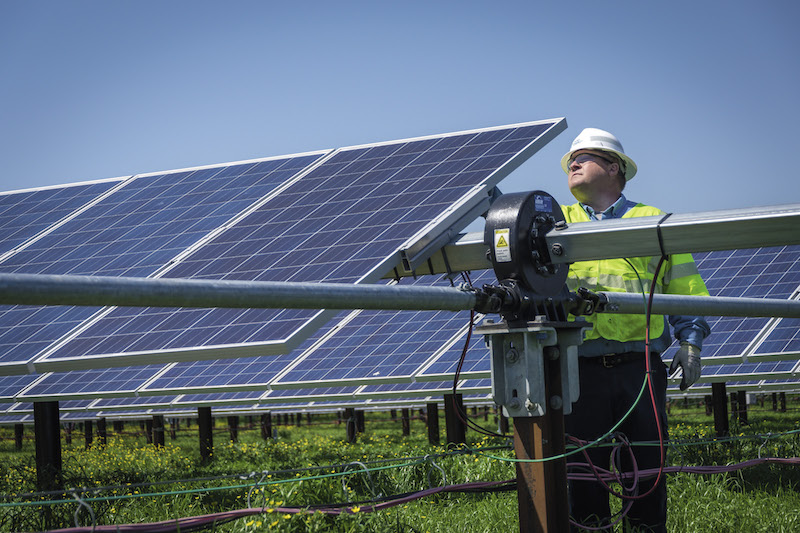By Abigail Ross Hopper, SEIA and Martin Hermann, 8minutenergy
A recent report by GTM Research and the Solar Energy Industries Association shows what the future of solar energy looks like. In what is now an established trend, a big share of America’s solar power generation – nearly 70 percent – is coming from utility-scale projects, while distributed solar generation continues to create job and ease demand for old baseload electricity. Storage will help give a boost to both utility scale and distributed generation.
All Southeastern states, joined by Texas, Minnesota, Michigan and Massachusetts, proved last year that solar’s massive appeal is spreading far and wide. In many of these states, utility-scale solar is increasingly winning bids in direct competition with other electric generation sources because it is the best economic alternative- not simply because it also is the best environmental choice.
Utility-scale solar locks low-cost power in at stable and predictable prices, providing ten to as much as thirty years of affordable energy that won’t fluctuate in price like fossil fuels. Investments in solar are investments in a secure future- without the fear of stranded costs that accompany fossil-fuel generation. This is why the Arizona Corporation Commission recently imposed a nine-month moratorium on new gas plants, requiring utilities to examine solar, storage and other alternatives.
With continued innovation and price drops, we believe solar can account for five percent of all U.S. electric generation by 2022 and 15 percent by 2030. Reaching those heights would lead to 416 gigawatts (GW) of total electric generating capacity – enough to power the equivalent of nearly 80 million American homes.
Big projects are leading the charge, thanks to their low cost, high reliability and grid-friendly characteristics. The largest utilities are making solar a significant part of their portfolio. Duke Energy, DTE, Southern Company, Xcel and many other utilities have big plans for solar. During the solar trade case last year, they made sure to let decisionmakers know the immense impact a negative ruling would have on their companies. They recognize that solar will encompass a large portion of their future capacity — and that solar and storage are a winning pair that can be installed at an increasingly attractive price.
Utility-scale developers, including 8minutenergy Renewables, are building some of the world’s largest solar-plus-storage or “dispatchable solar” projects now, many of them in development in the Southwest. With costs already more attractive than bids from conventional renewables, stand-alone batteries, or natural-gas peaking plants, the dispatchable solar market is poised for huge growth.
Another example is Arizona Public Service (APS), which will add a 50 megawatt (MW) battery system paired with a new 65 MW solar plant to its fleet. The regulated utility signed a 15-year PPA with First Solar, and the plant should be up-and-running in 2021.
Arizona is far from alone in looking to solar to play an increasingly large role in its energy future. Last month, Florida Power & Light announced that it had installed a solar-plus-storage system that integrates battery technology with an existing utility-scale solar power plant (built in 2016).
In January, an Xcel Energy solicitation in Colorado set a new solar-plus-storage record after attracting a median price of $36 per megawatt-hour. Georgia has built more than 1,000 MW of utility-scale solar and is planning to build another 1,000 MW. Again, the choice was one of basic economics: solar power plants beat the cost of acquiring conventional power.
Some of the country’s most sophisticated companies also are getting involved. Apple and Google each signed more than 500 MW worth of power purchase agreements (PPAs) last year alone, and many others are following suit. This trend isn’t limited to high-tech companies: companies like Walmart, in addition to putting solar on their own rooftops, are also entering into long-term contracts for low-cost utility solar.
Economics, grid reliability and environmental benefits all point to solar as the answer. That is why solar continues to surge. Storage will help provide electricity when the sun is not shining.
The data shows the solar revolution is well under way and will benefit not only our industry and its hundreds of thousands of workers, but also all of the nation’s consumers and businesses. We can’t wait to watch it transpire.
Abigail Ross Hopper serves as the president and CEO of the Solar Energy Industries Association. Martin Hermann is founder and CEO of 8minutenergy Renewables, LLC.
This content is protected by copyright and may not be reused. If you want to cooperate with us and would like to reuse some of our content, please contact: editors@pv-magazine.com.








Beatiful article keep them coming!